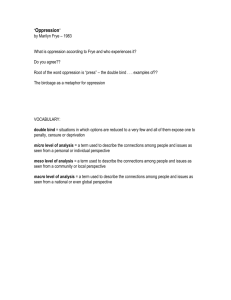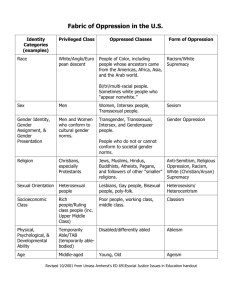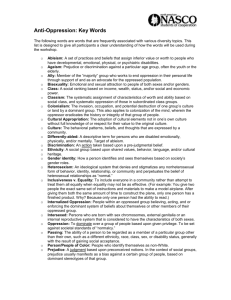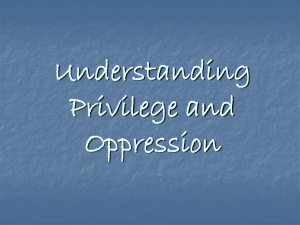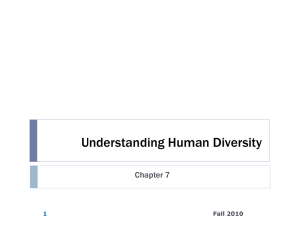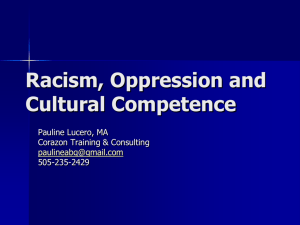Forms of Oppression
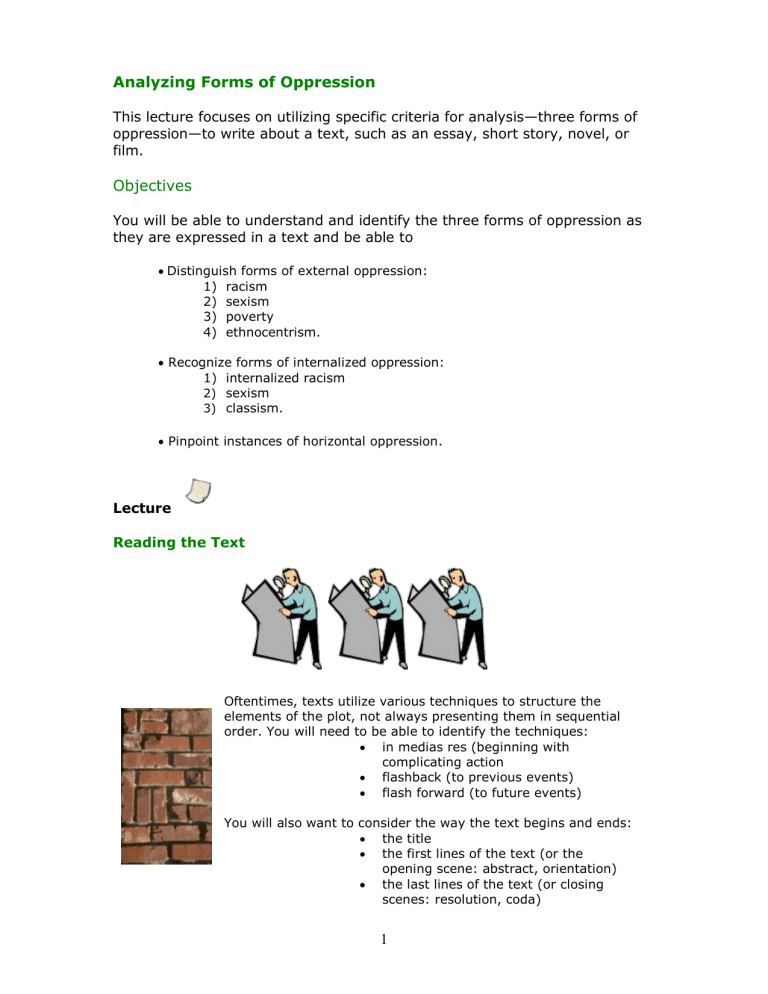
Analyzing Forms of Oppression
This lecture focuses on utilizing specific criteria for analysis—three forms of oppression—to write about a text, such as an essay, short story, novel, or film.
Objectives
You will be able to understand and identify the three forms of oppression as they are expressed in a text and be able to
Distinguish forms of external oppression:
1) racism
2) sexism
3) poverty
4) ethnocentrism.
Recognize forms of internalized oppression:
1) internalized racism
2) sexism
3) classism.
Pinpoint instances of horizontal oppression.
Lecture
Reading the Text
Oftentimes, texts utilize various techniques to structure the elements of the plot, not always presenting them in sequential order. You will need to be able to identify the techniques:
in medias res (beginning with
complicating action flashback (to previous events) flash forward (to future events)
You will also want to consider the way the text begins and ends:
the title
the first lines of the text (or the opening scene: abstract, orientation)
the last lines of the text (or closing scenes: resolution, coda)
1
Sometimes a text utilizes a structure that creates a circular closure, that is, it circles back from an element present at the beginning of the story or film
(such as a description of a character, dialogue, or a setting or place), to that same element at the end of the story or film.
Main Points and Supporting Detail . In order to identify main points or ideological concepts that are presented in a text, one must first decide upon the criteria for analysis he or she will use. Oftentimes in college, an instructor will give an assignment that identifies these criteria, in this case the three forms of oppression. However, you might be asked to find main points on your own, which then involves identifying the thesis (or abstract, in the case of a narrative, along with the evaluation and resolution). You will use annotation and reading strategies to find the main points and detail supporting them:
Annotation.
When analyzing a text for any criteria for analysis, it is important to first familiarize yourself with the text thoroughly, reading or watching it several times; you must also annotate the text if it is in print or digital form, highlighting and noting examples of the criteria you are exploring; if it is a film, you’ll need to take good notes and write down examples of the criteria for analysis you identify. Most expressions of oppression will occur through characterization, that is, the way in which characters in a literary work or film are constructed, usually through
● dialogue ● action ●description
Reading Strategies .
Remember to follow these reading strategies:
1.
Read the text (or watch the film) in its entirety to get an overview;
2.
Re-read (or watch a second time), highlighting main points and writing brief summaries in the margins (or summarizing the plot in your notes for a film);
3.
Re-read the text again (or watch the film again), this time identifying characters who exemplify the criteria for analysis, in this case the three forms of oppression;
4.
Annotate the text by underlining examples and writing down quoted and paraphrased material that connects to the three forms of oppression;
5.
Review your notes and annotations, exploring for an overall argument or point that the text is making about oppression.
2
Lecture
Definitions of Oppression
Many theorists have attempted to define oppression. Marilyn Frye, who writes about sexist oppression in particular, explains an important element of the word:
“[T]he root of the word ‘oppression’ is the element ‘press.’ The press of the crowd; pressed into military service; to press a pair of pants; printing press;
press the button.
Presses are used to mold things or flatten them or reduce them . . . Something pressed is something caught between or among forces and barriers which are so related to each other that jointly they restrain, restrict or prevent the thing’s motion or mobility. Mold. Immobilize. Reduce.”
● Misuse of the Term
For good reason, Frye contends that "oppression" is a strong word that “is much misused, and sometimes not innocently.” Indeed, many people use the term “oppression” for experiences that do not really constitute the systemic and pervasive restriction of opportunities and life choices that occurs when one is indeed oppressed.
● Cage Analogy
Frye, like other writers, such as Maya Angelou in her autobiography I Know
Why the Cages Bird Sings, uses the analogy of a cage to explain oppression.
As professor Stephen Chilton of the University of Minnesota points out, oppression takes place when people are trapped in cages with no way to escape; one cannot really see or comprehend the individual bars that make up the cage—only being outside of the cage, able to see the entire structure, how all the barriers operate together, informs us of what true oppression is.
“The wires don't make the cage,” Chilton explains, “their systematic arrangement does.”
(See professor Chilton’s article discussing Frye’s explanation of oppression at his website: http://www.d.umn.edu/~schilton/1610/Readings/1610.B+DReader.Frye.Opp
ression.html
).
3
It is this systemic aspect that makes oppression far more than individual instances of
● stereotyping ● prejudice ● discrimination ● bias
The University of Arkansas’s archival definitions web page
( http://uark.edu/~pride/archives/definitions.htm
) provides an excellent definition that helps to clarify what oppression really is:
“OPPRESSION: The systematic exploitation of one social group by another for its own benefit; it involves institutional control, ideological domination, and the imposition of the dominant group's culture on the oppressed group.
Oppression is different from discrimination, bias, prejudice, or bigotry because:
it is pervasive -- woven throughout social institutions as well as embedded within individual consciousness
it is restricting--structural limits significantly shape a person's life chances and sense of possibility in ways beyond the individual's control
it is hierarchical--the dominant or privileged groups benefit, often in unconscious ways, from the disempowerment of subordinated or targeted groups
the dominant group has the power to define and name reality and determine what is ‘normal,’ ‘real,’ or ‘correct.’”
Lecture
Ways to Identify Oppression
To understand oppression fully, it is important to distinguish it from other related terms such as “prejudice” and “discrimination.”
Prejudice.
The classic definition of prejudice comes from the famous
Harvard psychologist, Gordon Allport, who states in his 1954 The Nature of
Prejudice: "Prejudice is an antipathy based on faulty and inflexible generalization. It may be felt or expressed. It may be directed toward a group or an individual of that group." Prejudice is thus a negative belief which may or may not be expressed, and it is rooted in a logical fallacy: hasty generalization. It isn’t so much an emotion, as it is a form of pre-
4
judgment, that is, a passing of judgment before one has even met an individual or group of people. It is similar to bias, as it is a belief held regardless of objective, factual information.
Discrimination.
Discrimination differs from prejudice in a very significant way. While the word “prejudice” as it is often utilized today refers to a negative, perhaps even a hostile or violent, perspective towards an individual or group, “discrimination” is not a belief or attitude but the expression of it through a particular behavior, action, treatment, or outcome, such as
● Unfair employment or housing practices
● Sexual harassment
● Hate crimes
Prejudice and discrimination often occur on the basis of race (physical characteristics like skin color) or ethnicity (traditions, cultural practices, outlooks), as well as gender (male/female) and sexual orientation (gay, lesbian, bisexual, transgender or transsexual); however, other forms occur, such as that based on socio-economic class, physical ability, religion, HIV status, age, and so forth.
Reprinted from the Center for the Study of Violence and Reconciliation.
Prejudice can lead to discrimination, but it doesn’t have to; prejudice can take place without discrimination occurring, and vice versa. One must have the power to act upon one’s prejudice, which is not always the case, and sometimes one discriminates as part of an institutional or societal setting, even though the individual’s beliefs are
5
not themselves prejudiced. A person can be engaging in institutional discrimination, or “policy,” without being prejudiced himself or herself.
Out-Groups and In-Groups . Professor Tom O’Connor of Wesleyan College, drawing from R. Williams” seminal 1964 analysis of minority and majority groups in American
Society, presents the following definitions of “out-goups” and “in-groups”; these definitions are is useful in understanding externally oppressed groups versus those engaging in the external oppression:
THE DEFINITION OF MINORITY GROUPS (OUT-GROUPS):
1.
“They are oppressed or persecuted at the hands of a dominant group, and as a result of the power differential that develops, they are disadvantaged, and the dominant group is advantaged.
2.
They are distinguished by physical or cultural traits that distinguish them from the dominant group, allowing them to be easily "lumped" together and
"placed" is less desirable locations.
3.
They are self-conscious, with an idea of one-ness or peoplehood, based upon the perception of common suffering and burdens.
4.
Membership is not voluntary, but is instead an ascribed position where the person is born into this status.
5.
By choice or necessity, they usually marry within their own group
(endogamy). It is by choice to preserve a unique cultural heritage or by necessity because the dominant group scorns or discourages intermarriage.
THE DEFINITION OF MAJORITY (DOMINANT) GROUPS (IN-GROUPS):
1.
They have an attitude that they are superior to minority groups.
2.
They believe that minority groups are by their nature different and alien.
3.
They believe that they have a proprietary claim to privilege, power, and prestige.
4.
They have a fear and suspicion that minority groups have designs on dominant group benefits.”
Prejudice and Discrimination are often necessary for oppression to exist, as are the existence of the two groups—“out-groups” and “in-groups.” Oppression, however, can be identified from the following characteristics:
It reduces and restricts choices
It is systemic and pervasive
Its effects are long-term
Its power structure makes it difficult to overcome
Its power structure makes it difficult to overcome
Thus, multiple instances of discrimination must occur over time to constitute oppression, and a pervasive environment of both prejudiced thought processes and
6
discriminatory action must occur to create the systemic, condensed, and restrictive circumstances of oppression.
Lecture
Three Forms of Oppression
Oppression can occur in a variety of forms, but it is useful to consider the way it operates directionally: externally, internally, and horizontally; that is, oppression can function as a force directed from outside an individual or group, from within the individual or group, as well as across oppressed individuals and groups. The oppressive situation derives first from the outside, then is internalized, and then is often misdirected towards others who are oppressed, which keeps the oppressed individual or group from fighting the external oppression.
External Oppression . External oppression occurs when an individual or group with power harms an individual or group without power. It is important to distinguish between power and privilege. One can be privileged, for example, in terms of class or race, but not oppress those of other classes and races who are not privileged. One can use her privilege, and the power it affords her, to help versus harm those without power and privilege. However, when an individual chooses to use that power to exploit others without it, then he is engaging in oppression.
It is crucial not to correlate identity with external oppression in a simplistic manner; that is, we cannot assume that all white people engage in racist oppression, or all men are sexist oppressors. Oppression is far more complex. Also, one can hold prejudicial beliefs and not act upon them; the actions— repeated, systemic, and powerful—are what create the external oppression.
Chart I below provides some examples of beliefs and corresponding actions connected to forms of external oppression such as
● Racism
● Sexism
● Classism
● Homophobia
● Ableism
Of course, external oppression takes many forms not covered in the chart, including religious persecution, genocide, political repression, speciesism, the abuse and enslavement of children by adults, and so forth.
7
Chart 1: External Oppression
Beliefs Actions
Racism
Individuals of another race are inferior, perhaps not even human.
They are stupid, lazy, dangerous, strange. They deserve to be exploited and abused. They do not deserve to live in the same neighborhoods, go to good schools, have the same employment opportunities, or have the same rights as one’s own race.
No mixing of races.
Engaging in verbal harassment, intimidation, violence, stealing land and property, forcing those of a different race to live in substandard housing and attend low-quality schools.
Preventing personal, social advancement; engaging in political, social disenfranchisement.
Sexism
Women are inferior to men physically, intellectually, and emotionally. Their purpose is to attract males and serve them; their roles are restricted to sex object, wife, and mother. They must fit a rigid and harmful beauty ideal and should not fulfill any personal goals. They do not deserve to be in positions of authority or power.
Making sexist remarks, engaging in sexual harassment and sexual and physical abuse.
Not hiring qualified women or preventing their career advancement (“glass ceiling”).
Encouraging conformity to a sexist beauty ideal. Expecting women to do all childcare and domestic duties.
Classism
Poor and working-class people are stupid and lazy; they do not deserve a good education, decent housing, food, clothing, social services, or respect. They should serve middle- and upper-class people. They are often criminals, do drugs, and have too many children.
Not providing opportunities for poor and working-class people to improve their lives, exploiting them as workers and tenants. Engaging in verbal harassment, intimidation, and violence.
Homophobia
Gay, Lesbian, Bisexual and
Transgender people (GLBT) are abnormal and deviant; many are child molesters. They should hide their sexual preferences or change to become heterosexual, which is normal. They should not be permitted to live near “normal” people or have the same rights as heterosexuals.
Verbally abusing GLBTs, discriminating against them in education, employment, and housing, violence towards
GLBTs, forcing children and teens who are GLBTs to undergo therapy to become heterosexual or severing familial ties with them.
Ableism
People with disabilities are abnormal.
They should not engage in the same activities that able-bodied people do.
They should stay away from “normal” people, as they are freaks. They are a burden to others. They expect special rights and privileges. No one would want a relationship with them. They are to be pitied, ignored.
Verbally abusing disabled people or engaging in physical violence towards them.
Preventing them from activities they are capable of by not providing reasonable accommodation. Refusing to have relationships with them.
8
Internalized Oppression . Internalized oppression occurs when an oppressed individual or group believes in the messages of the oppressors, thus harming themselves by becoming exactly what the oppressors want and consider them to be. This form of oppression is often accompanied by feelings of
● low self-worth
● low self-esteem
● repressed anger
● hopelessness
● despair
Maya Angelou’s poem, “Caged Bird,” refers to the oppressed individual who is
“trapped by his bars of rage”; that is, his own anger and despair immobilize him. Often, oppressed people remain silent, keep their feelings inside, and do nothing to speak out against their oppression.
When people who are both externally oppressed and internally oppressed do take action, it is often harmful to themselves; because they believe the messages of the oppressors, they behave as the oppressors believe they should: fulfilling prejudiced stereotypes and the restrictive roles places upon them externally. The internalized oppression becomes a form of what Bob
Marley termed “mental slavery.” The internalized oppression solidifies and strengthens the external oppression, making the bars of the cage even more difficult to break through.
Emancipate yourselves from mental slavery;
None but ourselves can free our mind.
--Bob Marley “Redemption Song”
The following chart demonstrates the way in which negative internalized messages, the “mental slavery” Marley refers to, can translate into actions that keep people oppressed externally by racism, sexism, classism, homophobia, and ableism from fighting their oppression and improving their lives:
9
Chart 2: Internalized Oppression
Internalized Messages
Racism
Individuals of my race are not capable of achieving success. We are not worthy of a good education or high-paying jobs. We are not intelligent, nor do we have a good work ethic. We engage in criminal activity and/or exploit the welfare system. We do not deserve the same rights and treatment as whites in our society.
Actions
Not insisting on good schools or making education a priority.
Failing/Dropping out of school.
Working low-paying, lowskilled jobs, not seeking to advance. Poor performance at work. Engaging in criminal activity, collecting welfare. Not fighting discrimination.
Sexism
Women are not as important or capable as men. Our purpose is to attract males; our roles are restricted to sex object, wife, and mother. If we don’t fit the beauty ideal, we are worthless. We should not fulfill personal goals. We do not deserve to be in positions of authority or power.
Not attempting maledominated activities, such as math and science. Obsessing about appearance; having eating disorders. Focusing on
“getting a man” instead of fulfilling one’s goals. Not taking steps to advance in education or career.
Classism
Poor and working-class people are not intelligent or capable; we do not deserve a good education or to earn what middle- and upper-class people do. We do not deserve decent housing, food, clothing, social services, or respect in society. We are lazy and engage in negative behavior such as criminal activity, doing drugs, having too many children.
Accepting low quality schools and not attending college.
Staying in low-paying, dissatisfying jobs. Accepting unacceptable working and living conditions, such as rundown housing. Having poor work ethics and engaging in negative behavior such as crime, drugs, promiscuity.
Homophobia
Gay, Lesbian, Bisexual and
Transgender people (GLBT) are not normal. We do not deserve to be who we are. We do not deserve access to housing or jobs or to be able to marry or have children. We are promiscuous and immoral. We must remain in the closet. The history and contributions of GLBTs are irrelevant.
Engaging in self-destructive behavior, such as promiscuity; committing suicide. Doing nothing when discriminated against in housing or jobs. Not expressing one’s identity, remaining “in the closet.” Not learning about contributions of
GLBTs currently or historically.
Ableism
People with disabilities are inadequate and abnormal. We are not capable of working. We do not deserve to be in healthy, fulfilling relationships. We are a burden to others. We cannot engage in the same activities as those who are able-bodied, such as sports, education, politics, etc.
Not striving to do one’s best in school or achieving a higher education. Collecting welfare versus working a fulfilling job or profession. Avoiding making friends or having relationships.
Not trying to engage in activities or working towards one’s goals.
10
Horizontal Oppression.
Horizontal oppression takes place when individuals or groups who are externally and internally oppressed take their repressed anger towards their oppressors, their pain and their despair out on other oppressed individuals or groups, sometimes within their own group or across oppressed groups.
Some common examples of horizontal oppression include
● Hostile competition among women for men
● Impoverished whites attacking immigrants for “stealing jobs”
● Black-on-black crime
● Gang violence
Black-on-black crime and gang violence are instances where oppressed groups, feeling powerless to resist the larger forces of racism, ethnocentrism, and poverty that oppress them, have internalized the oppressive beliefs that they are not capable of being more than violent criminals; indeed, they seem to revel in the stereotypes and roles, acting them out to the point of destroying not only their own lives but the lives of others in their communities, whether they are fellow gang members or innocent victims. Sadly, it is often the high achieving high school or college student who ends up killed in a case of “mistaken identity” by a gang member, whether of his own race or not.
The following chart provides some examples of the ways in which internalized messages and their accompanying actions can be directed horizontally towards other oppressed people, preventing those with common issues and problems from joining in solidarity to resist their external oppression:
Chart 3: Horizontal Oppression
Internalized Message/Action
Racism
Young men of our race engage in criminal activity. We dress like gangsters and join gangs.
Horizontal Action
Fighting with gang members of one’s own or of other races, killing one another.
Sexism
Women must fulfill the beauty ideal to be attractive; therefore, some undergo cosmetic surgery even at the risk of their own health.
Putting other women down for not fulfilling the beauty ideal; encouraging daughters to have cosmetic surgery as teenagers.
Classism
Not feeling capable of advancement, working-class people stay in their low-paying jobs.
Parents encouraging their children to work versus focus on their education; belittling and preventing their attempts to go to college.
Homophobia
Gay, Lesbian, Bisexual and
Transgendered people (GLBT) not believing they can have a stable, committed relationship; engaging in promiscuous behavior.
Cheating on partners, lying, spreading STDs, encouraging others to engage in selfdestructive behavior.
11
Ableism
Due to feelings of inadequacy, not attempting activities that one is capable of doing; putting one’s self down and avoiding social situations.
Avoiding and ignoring others who are disabled, not engaging them in friendships.
Resources
The following articles are helpful for understanding oppression in its various forms.
Articles on Oppression:
“Beyond Victimization,” an essay on internalized oppression by Linda Frye
Burnham. http://www.dankwong.com/printables/beyond_essay.html
“The External Oppressor and Black Identity Wounding,” an article by
psychotherapist Aileen Alleyne on internalized oppression among blacks. http://www.kisskadee.com/papers/internal_oppressor_black_identity_wounding.pdf
“The Internal Oppressor, the Veiled Companion of External Racial Oppression,” another article by Aileen Alleyne http://www.kisskadee.com/papers/the_internal_oppressor.pdf
“Insights about Oppression,” an article by Tony Harris and Jacob Holdt. http://www.american-pictures.com/english/racism/oppression.htm
“Internalized Oppression and Latinos,” an article by Linda Padilla http://academic.udayton.edu/race/01race/latinos01.htm
Definitions Relating to Oppression:
“Definitions for Training in Diversity” by By Caleb Rosado, Ph.D.
http://www.rosado.net/articles-def.html
“Definitions Regarding Racism” adapted from Teaching for Diversity and Social
Change, ed. Maurianne Adams, Lee Anne Bell and Pat Griffin, © 1997, Routledge. http://www.centralcatholichigh.org/diversity_in_action_racism.htm
“Definitions of Terms Relating to Racism,” from Lehigh University.
http://www.lehigh.edu/%7Eincor/WorkingDefinitions.htm
12
Additional Sources:
Web site of Vernellia R. Randall, Professor of Law, providing links to articles on
Latino Americans and oppression http://academic.udayton.edu/race/01race/hislatam.htm
Chapter One of Paulo Freire’s Pedagogy of the Oppressed
http://www.webster.edu/~corbetre/philosophy/education/freire/freire-1.html
National
Resource Center for the Healing of Racism, includes links to resources http://www.nrchr.org/resources.asp?category=n/a
The Social Psychology Network, includes links to resources http://www.socialpsychology.org/social.htm#prejudice
13
